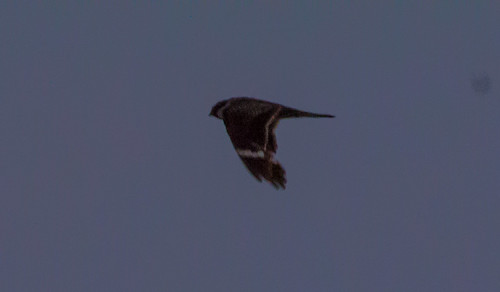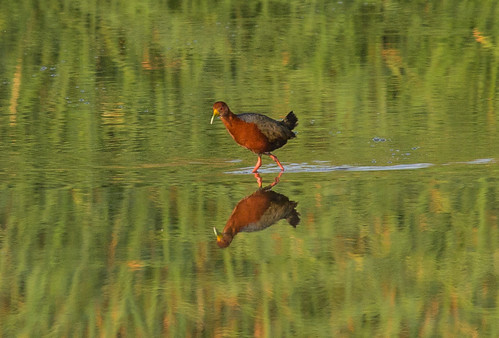On July 7, a young birder named Matt Daw was taking video of a Least Bittern in the Bosque del Apache National Wildlife Refuge in New Mexico when what to his wondering eyes should appear walking right into his recording but a Rufous-necked Wood-Rail! This bird, found from Mexico to northern South America, is considerably larger than the rails we see in the United States. Until Matt’s bird showed up, it has never been reported on our side of the border before, making it what the American Birding Association calls a Code 5, so birders from throughout the country flocked to the refuge to see it. At least two of the birders the book and movie The Big Year was based on showed up.
I’ve never chased a national rarity like this before, and my focus is on naturally-occurring species, not vagrants, but since I had to get down there anyway for my Conservation Big Year, I figured I might as well time my trip to at least try to see the wood-rail, which would be a lifer. I also thought it would be cool to do one big chase in my lifetime.
The very same wings that carried the bird to Bosque del Apache could pick it up and carry it anywhere else whenever it wanted, so the idea of traveling any distance at all to chase this kind of vagrant seems preposterous. Bosque del Apache includes at its core about 8,000 acres of wetlands, a large haystack within which was just one out-of-place needle, but for reasons of its own, the bird was centering its activities in one small marshy area. It was impossible to see it within the dense cattails, but once or twice most days, it walked into an open area in full view from the boardwalk on the wildlife auto loop. So starting at dawn each day, hopeful birders from all over the country gravitated to the boardwalk to watch for it. Many brought lawn chairs and umbrellas to protect them from the hot sun.
I didn’t have a chance to get away until Friday the 12th, when the bird had already stuck around for almost a week—an improbably long period. I left home on Friday but took a detour through Madison, Wisconsin, so it took three days to cover the 1700 miles. Whenever I stopped, I checked one of the American Birding Association’s Facebook pages, so I knew people were still seeing the wood-rail. I arrived at the refuge about 6 pm Sunday. The bird had last been seen a few hours before. Most days it made a final appearance at dusk. I stuck around till after dark, getting lovely views (albeit crappy photos–it was too dark!) of Lesser Nighthawks, which were new for the year, but no Wood-Rail.
I’m sort of shy, but the jolly and expectant atmosphere on the boardwalk made conversation easy and fun. People sat or stood around, patiently waiting for a momentary eruption, reminding me of being at Yellowstone watching for Old Faithful, except the wood-rail’s appearances could not be predicted with any regularity at all, and unlike a geyser, at any moment the rail could pack up and leave, or be eaten by a predator, so there were no guarantees that it would ever appear again.
The next morning, I slept until after 6, exhausted after the grueling drive, and didn’t get to the refuge until after 7:30. The bird had been seen many mornings right at dawn, but not this time. I felt better that I’d at least not missed it, but even though I stayed in the right spot most of the day, hour after hour the rail didn’t show up. Sandy Komito, the birder Owen Wilson’s character in the movie The Big Year was based on, was there all day, too, telling stories and contributing to the festive mood. I waited until after 6 pm, but had to run a couple of errands in Socorro, 22 miles away. Rather than drive all the way back, I returned to my motel, exhausted. Sandy Komito threw in the towel not long after I left.
Before going to sleep I checked Facebook one last time. Right before dusk the bird had come out for a nice long showing, providing great looks for everyone who’d stuck it out on the boardwalk and for those who chanced to arrive just in time. Oh, well. I was having such a good time watching other birds, including new species for my Conservation Big Year list, that it didn’t seem all that critical to me whether I saw the Wood-Rail or not. But a lot of people were rooting me on, and I was starting to get the feeling that I’d be letting them down if I didn’t see it. So Tuesday night I set my alarm for 5 am. I had to load up my car and check out of my motel room in Socorro Wednesday morning, but was on the road before the sun was up.
It had rained the night before, and the rising sun as I drove down the final stretch out of San Antonio produced a beautiful rainbow that filled the sky ahead of me. That felt portentous. I was anxious to get to the refuge boardwalk, but don’t drive anywhere close to the speed limit on that road—there are just too many animals out in early morning. So I moseyed, making it to the boardwalk about 7. Everyone there was looking at the same point in the water, where two stunning Black-necked Stilts seemed to glow in the sun.
But the birders weren’t looking at the stilts—the Rufous-necked Wood-Rail was right next to them, even more stunning than I’d imagined, almost glowing in the sunlight, its reflection in the water lit up as beautifully as it was.
It slowly worked its way to the muddy shore by the cattails, then headed back in the water for a bit longer, and finally skulked into some cattails. It had been out for quite a while before I arrived. Sandy Komito had already seen it and left by the time I arrived, so I didn’t get to see how one of the world’s biggest bird chasers reacts when he sees a new bird, but as a one-time-only chaser, I was sure happy.
We can’t really call the Rufous-necked Wood-Rail a rarity, because it’s fairly common in its normal range. What brings such an exceptional bird so far away from home? Most vagrants appear during migration season, or following major storm systems. Of course, we don’t know if this bird had been at Bosque for days or weeks before Matt Daw first discovered it—the refuge is one of the most popular in the entire National Wildlife Refuge system, and is incredibly heavily birded during fall, but doesn’t get much attention in summer, so we can’t be certain whether the wood-rail took a wrong turn during migration or left its home range during the breeding season. It’s quite possible that this year’s exceptional drought and hot weather were related, or that habitat destruction sent it packing.
One of the reasons I don’t like chasing vagrants is that the long-term prognosis for so many of them is poor. While I was working at the Cornell Lab of Ornithology, a Magnificent Frigatebird turned up in Ithaca, New York, following a major hurricane. That poor out-of-place wanderer was found dead the morning after it first appeared and is now lying in state in the Lab’s specimen collection. I was glad I hadn’t gone to see it—I’d have felt sad whenever I saw that check on my New York state bird list. But major changes in climate and continued habitat destruction are going to force many birds to find new homes or die out, so we can expect more and more out-of-range birds to appear here and there in the coming years, even as more and more species dwindle and disappear.
There’s at least a glimmer of hope that wildlife refuges like Bosque del Apache will provide a safe haven for some of these wanderers, but whether these relatively tiny refuges can sustain viable populations of increasing numbers of desperate species is unlikely. The Bosque del Apache refuge was purchased in the first place with federal Duck Stamp money. I will never be a hunter, but I happily paid for one-day pass to Bosque and I purchased two Duck Stamps—one to keep, and one to sign. That one will give me free admission to other wildlife refuges for the next year, but I’ll probably pay the day admission to them, too. It takes a bite out of my limited discretionary income, but supporting these jewels of habitat is far more important than most other things I could buy.
I spent the rest of the day on Water Canyon, just 15 miles out of Socorro. That is the farthest east and north where one can see Red-faced Warblers.
My luck held—I photographed one gorgeous male, and then went to the campground to spend the night. We had a brief shower, so my day ended as it began, with a lovely rainbow.






